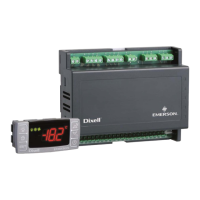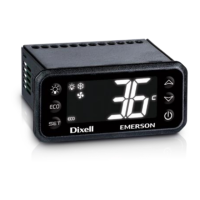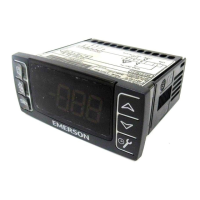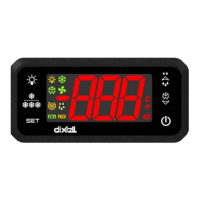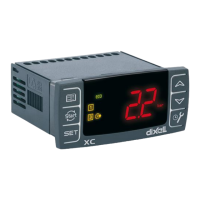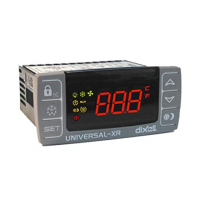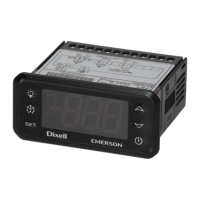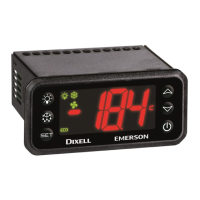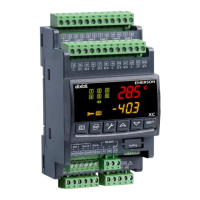1592023130 XM670K_XM679K GB r4.2 26.06.2017.docx XM670K - XM679K 8/10
Rel Release software: (read only) Software version of the microprocessor.
Ptb Parameter table: (read only) it shows the original code of the Dixell parameter map.
Pr2 Access to the protected parameter list (read only).
17. DIGITAL INPUTS
The XM600 series can support up to 3 free of voltage contact configurable digital inputs (depending on
the models). They are configurable via i#F parameter
17.1 GENERIC ALARM (EAL)
As soon as the digital input 1, 2, or 3 is activated the unit will wait for “d1d” or “d2d” or “d3d”time delay
before signalling the “EAL” alarm message. The outputs status don’t change. The alarm stops just after
the digital input is de-activated.
17.2 SERIOUS ALARM MODE (BAL)
When the digital input is activated, the unit will wait for “d1d” or “d2d” or “d3d” delay before signalling the
“BAL” alarm message. The relay outputs are switched OFF. The alarm will stop as soon as the digital
input is de-activated.
17.3 PRESSURE SWITCH (PAL)
If during the interval time set by “d1d” or “d2d” or “d3d” parameter, the pressure switch has reached the number
of activation of the “nPS” parameter, the “CA” pressure alarm message will be displayed. The compressor and
the regulation are stopped. When the digital input is ON the compressor is always OFF. If the nPS activation in
the d#d time is reached, switch off and on the instrument to restart normal regulation.
17.4 DOOR SWITCH INPUT (dor)
It signals the door status and the corresponding relay output status through the “odc” parameter: no = normal
(any change); Fan = Fan OFF; CPr = Compressor OFF; F_C = Compressor and fan OFF. Since the door is
opened, after the delay time set through parameter “d#d”, the door alarm is enabled, the display shows the
message “dA” and the regulation restarts after rrd time. The alarm stops as soon as the external digital input
is disabled again. With the door open, the high and low temperature alarms are disabled.
17.5 START DEFROST (DEF)
It executes a defrost if there are the right conditions. After the defrost is finished, the normal regulation
will restart only if the digital input is disabled otherwise the instrument will wait until the “Mdf” safety time
is expired.
17.6 RELAY AUX ACTUATION (AUS)
This function allows to turn ON and OFF the auxiliary relay by using the digital input as external switch.
17.7 RELAY LIGHT ACTUATION (LIG)
This function allows to turn ON and OFF the light relay by using the digital input as external switch.
17.8 REMOTE ON/OFF (ONF)
This function allows to switch ON and OFF the instrument.
17.9 KIND OF ACTION (HTR)
This function allows to change the kind of regulation from cooling to heating and vice versa.
17.10 FHU – NOT USED
This function allows to change the kind of regulation from cooling to heating and viceversa.
17.11 ENERGY SAVING INPUT (ES)
The Energy Saving function allows to change the set point value as the result of the SET+ HES
(parameter) sum. This function is enabled until the digital input is activated.
17.12 CONFIGURABLE INPUT - HOLIDAY FUNCTION (HDY)
In Holiday function Energy saving and defrost cycles follow holiday times. (Sd1…Sd6)
17.13 DIGITAL INPUTS POLARITY
The digital inputs polarity depends on “I#P” parameters: CL : the digital input is activated by closing the
contact; OP : the digital input is activated by opening the contact.
18. USE OF THE PROGRAMMING “HOT KEY“
The XM units can UPLOAD or DOWNLOAD the parameter list from its own E2 internal memory to the
“Hot Key” and vice-versa through a TTL connector.
18.1 DOWNLOAD (FROM THE “HOT KEY” TO THE INSTRUMENT)
1. Turn OFF the instrument by means of the ON/OFF key ,insert the “Hot Key” and then turn the unit
ON.
2. Automatically the parameter list of the “Hot Key” is downloaded into the controller memory, the
“doL” message is blinking. After 10 seconds the instrument will restart working with the new
parameters. At the end of the data transfer phase the instrument displays the following messages:
“end“ for right programming. The instrument starts regularly with the new programming. “err” for
failed programming. In this case turn the unit off and then on if you want to restart the download
again or remove the “Hot key” to abort the operation.
18.2 UPLOAD (FROM THE INSTRUMENT TO THE “HOT KEY”)
1. When the XM unit is ON, insert the “Hot key” and push “UP” key.
2. The UPLOAD begins; the “uPL” message is blinking.
3. Remove the “Hot Key”.
At the end of the data transfer phase the instrument displays the following messages:
“end “ for right programming.
“err” for failed programming. In this case push “SET” key if you want to restart the programming
again or remove the not programmed “Hot key”.
19. TECHNICAL DATA
CX660 keyboard
Housing: self extinguishing ABS.
Case: CX660 facia 35x77 mm; depth 18mm
Mounting: panel mounting in a 29x71 mm panel cut-out
Protection: IP20; Frontal protection: IP65
Power supply: from XM600K power module
Display: 3 digits, red LED, 14,2 mm high;
Optional output: buzzer
Power modules
Case: 8 DIN
Connections: Screw terminal block
10% or 90÷230Vac
with switching power supply.
Power absorption: 9VA max.
Inputs: up to 6 NTC/PTC/Pt1000 probes
Digital inputs: 3 free of voltage
Relay outputs: Total current on loads MAX. 16A
Solenoid Valve: relay SPST 5(3) A, 250Vac
defrost: relay SPST 16 A, 250Vac
fan: relay SPST 8 A, 250Vac
light: relay SPST 16 A, 250Vac
alarm: SPDT relay 8 A, 250Vac
Aux: SPST relay 8 A, 250Vac
Valve output: a.c. output up to 30W (Only XM679K)
Optional output (AnOUT) DEPENDING ON THE MODELS:
PWM / Open Collector outputs: PWM or 12Vdc max 40mA
Analog output: 4÷20mA or 0÷10V
Serial output: RS485 with ModBUS - RTU and LAN
Data storing: on the non-volatile memory (EEPROM).
Kind of action: 1B. Pollution degree: 2 Software class: A. Operating temperature: 0÷60 °C.
Storage temperature: -25÷60 °C. Relative humidity: 20

